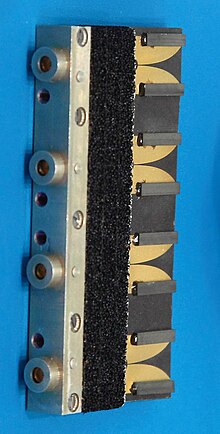Vivaldi antenna
The Vivaldi antenna (also: tapered slot antenna for "antenna with expanding slot"; short: TSA ) is a broadband antenna for the microwave range, which consists of a coplanar structure on a metallized dielectric substrate (picture) . The name goes back to Peter J. Gibson , who first described this antenna design in 1979 at the European Microwave Conference.
The individual radiator elements can be distributed on one circuit board level ( coplanar Vivaldi antenna ), on two levels ( antipodal Vivaldi antenna ) or three levels ( symmetrical antipodal Vivaldi antenna ). Antipodal Vivaldi antennas can be connected directly to a coaxial line.
functionality


Coplanar Vivaldi antennas are fed via a slot line . If the adapter electronics are in microstrip technology, a transition is necessary. This can be implemented in a relatively broadband manner if the stripline is terminated with a surface element in the shape of a sector of a circle . This creates a power node at the crossing point. The slot line, on the other hand, is closed with a circular free space that is a quarter wavelength long, likewise broadband. The actual antenna is a two-dimensional exponential horn that causes the directed radiation of a linearly polarized electromagnetic wave . Overall, there is a low-reflection transformation of the wave impedance of the stripline to the deviating free space wave resistance .
Vivaldi antennas can be set up for linear polarization or - if two antennas are arranged perpendicular to each other - for both polarization directions.
If the two orthogonal antennas are fed with a signal phase-shifted by 90 °, a circularly polarized wave is transmitted or received. The generation of a broadband constant phase shift of 90 ° is difficult to achieve.
The advantage of Vivaldi antennas lies in their simple production, in which the usual processes of printed circuit board production can be used, as well as their broadband capability and the simple adaptation to the feed line impedance with the help of modeling the stripline feed structure.
The Vivaldi antenna can be understood as a planar shape of a steghorn radiator .
Name origin
The naming of this planar microwave antenna is not fully understood. From the inventor Peter Gibson himself, who died in 2010, there is no written explanation of his choice of name. A friend and former colleague, however, who worked with him in the Philips research laboratory in the 1980s and stayed in contact with him until his death, reports on him:
“Peter was really into music, composing pieces, teaching piano in those days and was a church organist. He told me that he called the tapered slot antenna a "Vivaldi" as it looked like the cross-section of an early trumpet. Vivaldi had written a trumpet concerto, and it was the 300th anniversary of Vivaldi's birth in 1678. Anyway, that was Peter's own explanation of why he gave the name. ”
“Peter [Gibson] was really interested in music at the time, composed music, gave piano lessons and was a church organist. He told me that he called the adapted slot antenna "Vivaldi" because it looked like the cross-section of an early trumpet . [The Venetian composer] Vivaldi [(1678–1741)] had written a trumpet concerto, and it [the year 1978 that this antenna was developed] was the 300th anniversary of Vivaldi's birth in 1678. Anyway, that was Peter's own explanation for the naming. "
literature
- Peter J. Gibson: The Vivaldi Aerial Publication in the Conference Proceedings of the European Microwave Conference . Retrieved April 25, 2016.
- Alois Krischke: Rothammels Antennenbuch. 13th edition, DARC Verlag GmbH, Baunatal, 2013, ISBN 978-3-88692-065-5 , p. 371.
Web links
- Vivaldi Print Typical layout of a Vivaldi antenna. Retrieved April 27, 2016.
- Graphic simulation of the radiation of a Vivaldi antenna - University of Karlsruhe
- Yuan Yaoa, Wenhua Chen, Bin Huanga, Zhenghe Fenga, Zhijun Zhang: Analysis and Design of Tapered Slot Antenna for Ultra-Wideband Applications; Jan. 29, 2009 at http://www.sciencedirect.com
- Vivaldi antenna , Microwave Encyclopedia, engl. (queried on May 21, 2010)
Individual evidence
- ^ Tapered Slot Vivaldi Antenna
- ^ PJ Gibson: The Vivaldi Aerial . IEEE, 1979 (European Microwave Conference Article).
- ↑ Description of the Vivaldi antenna in the radar tutorial
- ↑ Vivaldi antenna on Microwaves 101.com (English). Retrieved April 25, 2016.

